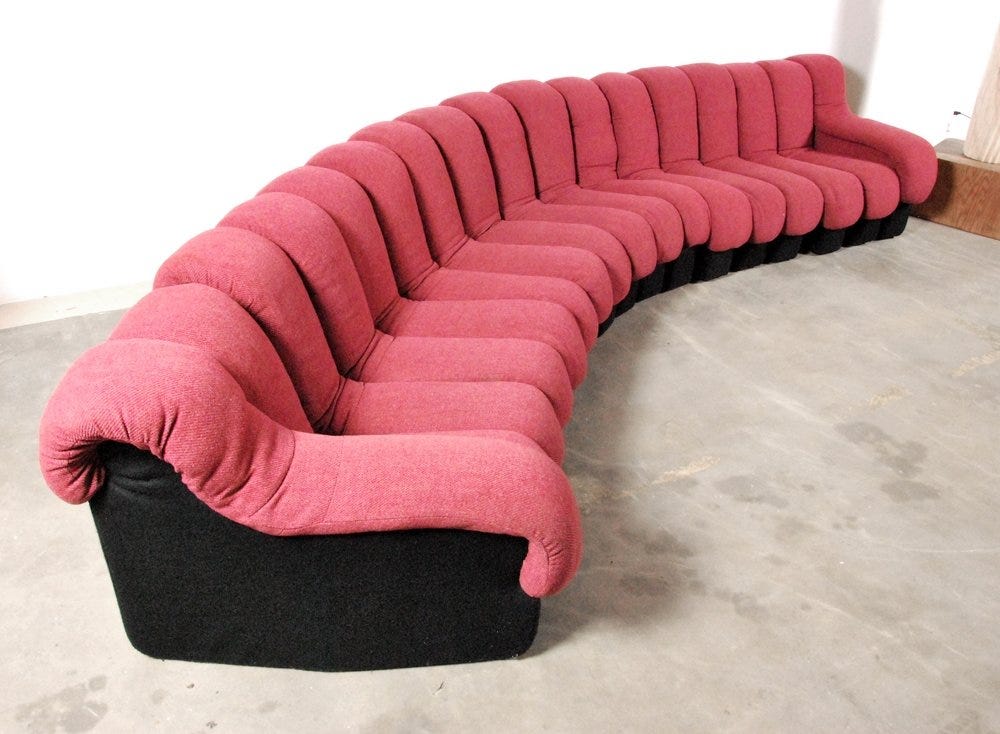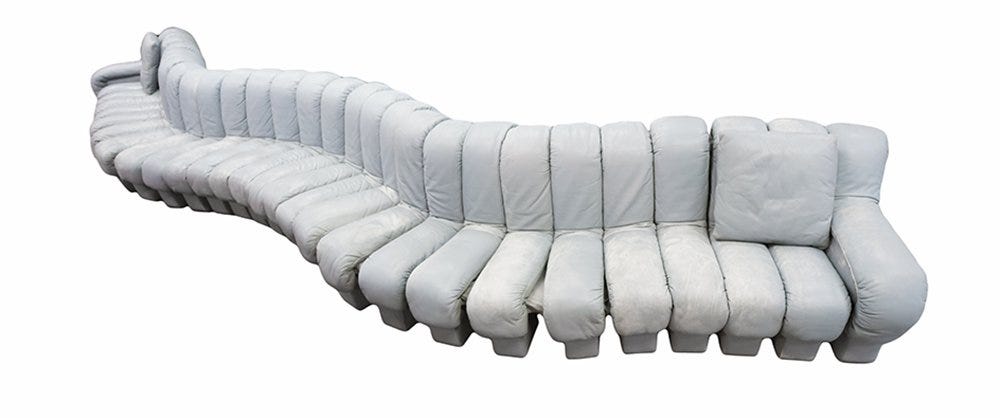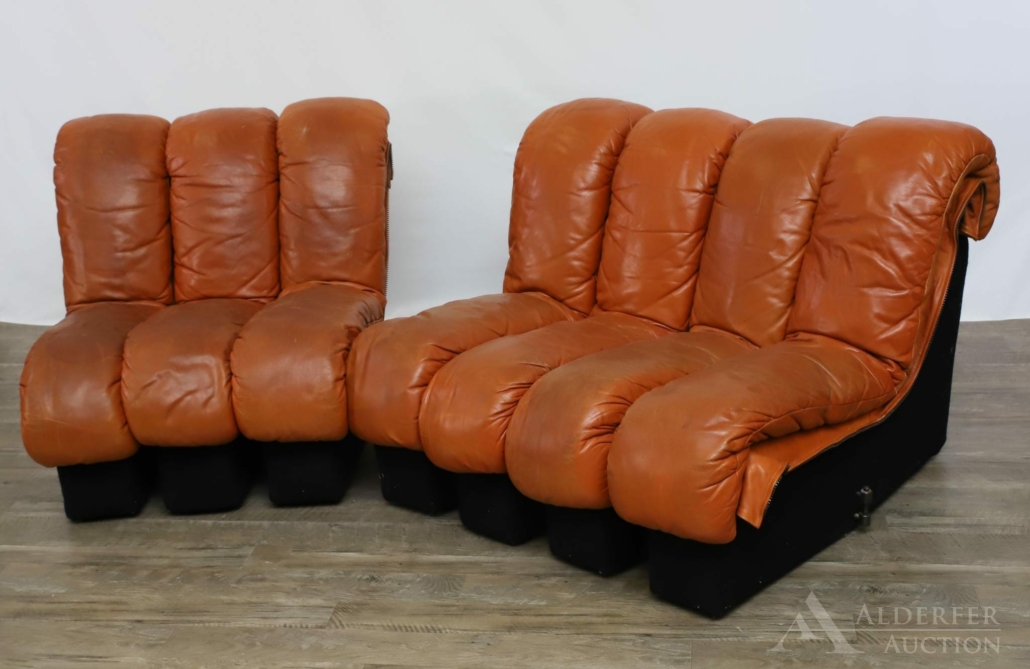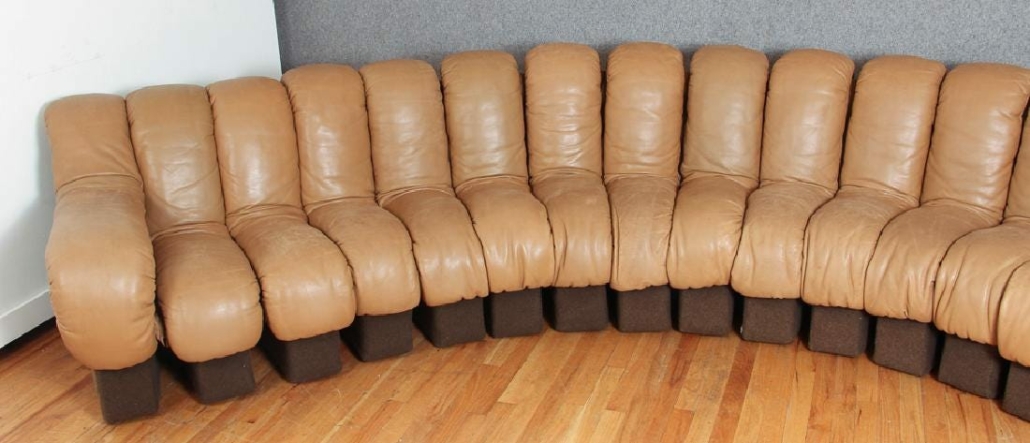
NEW YORK — The 1970s were not as celebrated for iconic furniture designs as the two preceding decades, when modern furniture came into its own. Still, the decade witnessed some historic contributions, and unquestionably, one of its most striking designs was de Sede’s DS-600 modular Non Stop sofa.
Swiss furniture maker de Sede launched this whimsical and unorthodox model in 1972 and is still making it today. A hallmark of several mid-century modern furniture designs, including the Non Stop, is the ability to offer nearly endless configurations, giving owners the flexibility to rearrange the seating pieces with ease or fit them into different room layouts.
Resembling a caterpillar or an accordion, the Non Stop sofa is composed of modular sections that are connected with hinges, but can be detached. They can be bent so the sofa forms a C, S, U, or an L. Sections can be removed or added to create a look to suit every taste. Some choose to keep their Non Stops perfectly straight.

De Sede began in Klingnau, Switzerland as a tanner’s workshop and has long been known as a maker of fine leather furniture that is versatile and comfortable. The DS-600–its formal name, according to the de Sede catalog–is the most well known of the company’s furniture designs. The Non Stop earned a place in the Guinness Book of Records as the world’s largest sofa with an example that boasted more than 400 connected sections. That record-setting behemoth was designed by the de Sede in-house team of Heinz Ulrich, Ueli Berger, Eleanora Peduzzi-Riva, and Klaus Vogt.
Interestingly, while the DS-600 has come to be known as the Non Stop sofa, this title seems to have not been used by de Sede. A Google search to find the genesis of this nickname yields no useful information, but the moniker has clearly stuck.
The company notes on its website that the sofa was actually named after a mythical creature in Alpine lore, the Tatzelwurm, which is said to be a long and slender lizard or worm-like creature that has the face of a cat.

“DS-600 is an indestructible, variable modular system of upholstered furniture consisting of individual, addable armchair elements,” according to its website.
The Non Stop sofa has sold well in Europe and in America. A major distributor in the early 1970s was Stendig Inc., then located on East 62nd Street in New York City with showrooms in Chicago, Los Angeles, and San Francisco. Blessed with a keen business acumen and interest in modern furniture, founder Charles Stendig was responsible for bringing the de Sede DS-600 and other key furniture designs to America. He was the exclusive American importer for notable furniture pieces made by Scandinavian and European firms such as Thonet and Breuer.

Aficionados of the mid-century modern aesthetic are often drawn to the Non Stop, and vintage examples in fine condition can sell for more than $10,000. A few sold at auction nearly 10 years ago brought a high price on LiveAuctioneers’ price results database, exceeding $20,000, with one topping the $30,000 mark. Color is, of course, highly subjective, but black and brown leather are classics that suit any decor and are desirable to collectors. Matched pairs are rare, and bring top prices accordingly. Befitting its status as a furniture icon, this sofa has appeared in several movies, including Scarface and the Hunger Games. It has also been a staple in elegant hotel lobbies and landmark buildings such as Chicago’s Playboy building, where it serves as a statement piece. The Non Stop sofa also proves that interior spaces need not be a fixed design; it offers seemingly countless configuration possibilities.
The challenges of the COVID-19 pandemic elevated the role of the sofa in the home, making it more than just a place to watch Netflix or answer work emails (or do both at the same time). It makes sense that people are drawn to this sofa for its flexibility, comfort, and unique look.

This iconic design from de Sede has achieved cult-like status in the last 40 years and it’s still winning over buyers. The Non Stop sofa has it all, and the happy owner of one of these furnishings can always create new arrangements.
# # #


